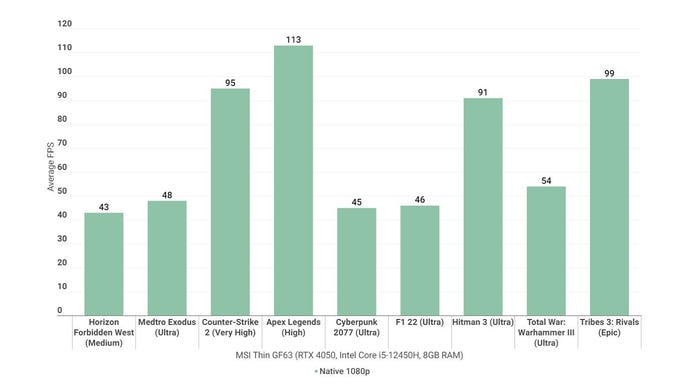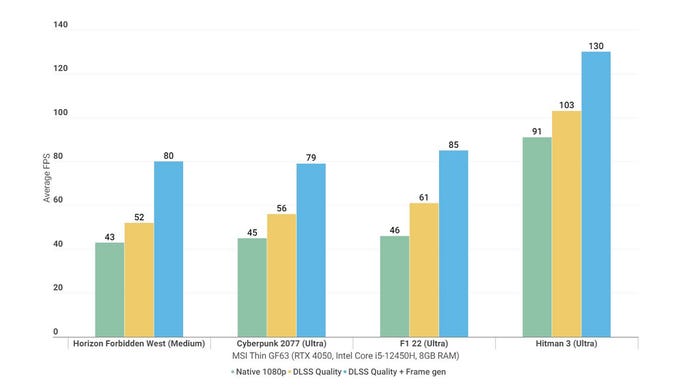A year on, the RTX 4050’s appeal has grown – but better laptop GPUs loom
DLSS 3 lets this entry-level mobile chip do what the Steam Deck can’t. Is that enough?
With a desktop version of the RTX 4050 looking less likely with every turn o’ the Earth, the true entry-level GPU among Nvidia’s current generation solely remains in the realm of gaming laptops. It’s also, I’ll admit, overdue some consideration on RPS. Between the lack of cheap graphics cards among the desktop RTX 40 series, the year-and-a-bit that DLSS 3 has had to grow its compatible games library, and the Steam Deck reminding everyone that portable, low-end gaming can still be pleasurable, now seems like the RTX 4050’s time to shine. Or, at the very least, gently twinkle.
To find out, I’ve been playing around with an MSI Thin GF63, which pairs the 4050 with an octa-core Intel Core i5-12450H and an easygoing 1920x1080 display. That’s not a whole lot of laptop, but then at £799 / $852, there are few cheaper ways to get a complete system with Nvidia’s Ada Lovelace architecture. Architecture which, again, unlocks DLSS 3 and its best-in-class frame generation tech. This was a useful bonus when the RTX 4050 launched early in 2023 and has only become stronger since, with the number of DLSS 3-ready games rapidly approaching the 100 mark. Frame gen isn’t perfect for every situation – the added input lag can be noticeable in twitchy shooters, say – but generally, it’s worth turning on when you can, and in theory, a cheapo GPU like the RTX 4050 can benefit more acutely from the uptick in frames-per-second.
That said, it’s not a total weakling without help. Even paired with a CPU from two Intel generations back, it can still go well beyond 60fps in plenty of widely-played games, using both high/ultra quality settings and native 1080p rendering.

Newer AAA games – or more demanding fare from yesteryear – present a steeper challenge, sometimes demanding settings cuts (as with Horizon Forbidden West) to stay smooth. Not to horrific degrees, mind – anything that the RTX 4050 can’t reliably run on maxed-out visuals, it should do on at least Medium. Just so long as that slightly old-fashioned 6GB VRAM reserve doesn’t get overwhelmed.
However, prospective laptop buyers should also know that for all the RTX 4050’s pep, it’s also soundly thrashed by the mobile RTX 4060. In Metro Exodus, for one there’s an instantly visible smoothness difference between the Thin GF63’s 48fps and the 72fps that the 4060-equipped HP Omen Transcend 16 scored with the same settings. That laptop also averaged 71fps in Cyberpunk 2077, which (if you don’t have Alice Bee’s questionable eyesight) will look and feel slicker than the 45fps of the Thin GF63.
This is more of an issue for the RTX 4050 than the usual GPU tiering considerations because right now, RTX 4060 laptops aren’t actually that much more expensive. Depending on how much you’re willing to compromise on bulk and/or CPU newness, a 4060 gaming notebook can be yours from as little as £800 / $777, easily enough for them to make hungry eyes at the 4050’s lunch.
In defence of the lower-end GPU, it’s much better at seeing off the rest of its competition. I’d still take an RTX 4050 laptop over a lower-priced RTX 3050 model in an instant, largely thanks to that frame gen support. Here, we can see how enabling DLSS 3 together with good old DLSS upscaling is enough to nearly double the RTX 4050’s frame output in compatible games:

(I know I’m sometimes iffy about using upscalers at 1080p, but they’re altogether more palatable on laptop displays than on desktop monitors. While both might share the same pixel resolutions, the former’s smaller sizes result in much higher pixel densities. As such, everything will therefore naturally look a little sharper, which helps hide the effect of upscalers setting a lower rendering resolution.)
Besides turning merely okay framerates into good ones, DLSS and DLSS 3 can also make the RTX 4050 a viable ray tracing tool. At native 1080p, Hitman 3’s infamously strenuous RT effects struck the Thin GF63 down from 91fps to 27fps, but DLSS on Quality mode bumped that back up to a playable 42fps before DLSS 3 frame generation produced am even tidier 64fps. Cyberpunk 2077 could also run comfortably on its Ray Tracing Low preset (which, despite the name, includes a bunch of Ultra-level quality settings) with the addition of DLSS, averaging 53fps with Quality upscaling and 62fps with frame generation on top.
As much as I love my Steam Deck, both it and more premium handhelds like the Asus ROG Ally can only dream of such performance, so the RTX 4050 clearly has an argument to make for itself as a budget gaming option.

But then, the mobile RTX 4060 does too, so long as its cheapest laptops stay so close to those of the RTX 4060. And that obviously has all the same DLSS bells and whistles, so it can push that FPS advantage over the RTX 4050 even further.
I still think the RTX 4050 could be a great laptop GPU, especially as the selection of games with frame gen support continues to grow. Maybe it just needs to double down on its budget positioning, with its lappies aiming more for the £600-£700 range: enough to effectively undercut its more powerful sibling, while offering way more pop for your pound than a ROG Ally, Lenovo Legion Go, or Steam Deck OLED.
For the time being, it’s still decent, albeit a harder sell. If the RTX 4050 really is the best mobile GPU you can afford, take solace in knowing that it will play anything at 1080p, and has the tools to ease the stress of the toughest games. But if you can afford to stretch to an RTX 4060 laptop... yeah, do that.









